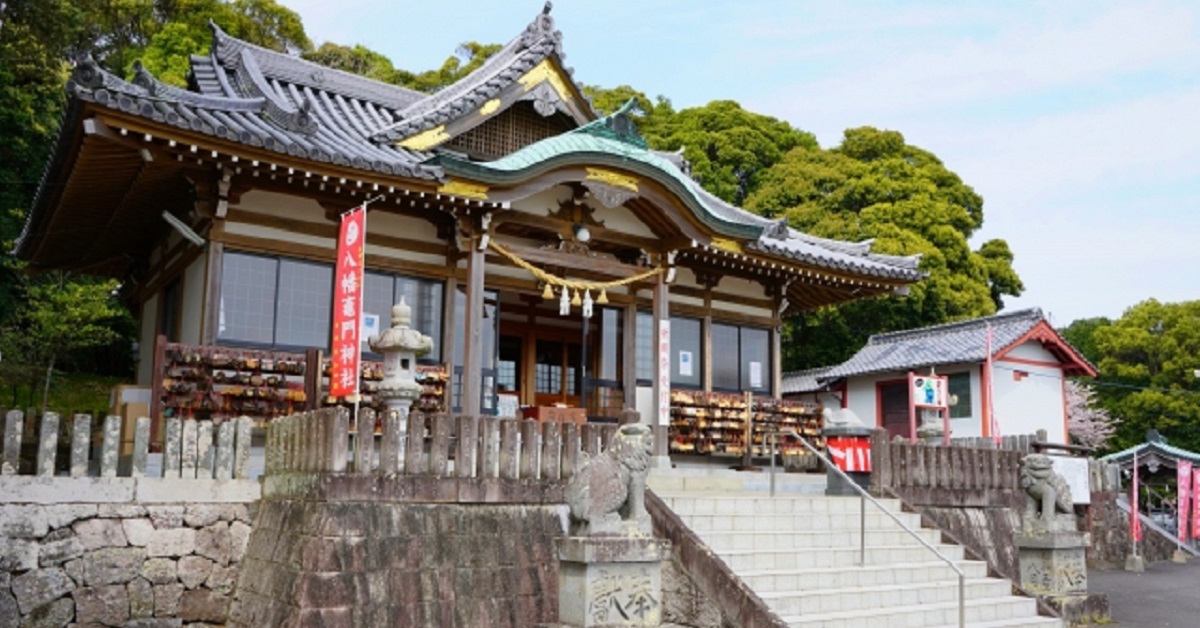Hachiman Kamado Shrine in Beppu, Oita is a place filled with traditions and legends that strongly resonate with the world of Demon Slayer. Tales of man-eating demons and the enduring Kamado Kagura dance allow visitors to feel the spirit of the story as they walk through its sacred grounds.
What is Hachiman Kamado Shrine?
Hachiman Kamado Shrine stands in Beppu, Oita Prefecture, surrounded by rich nature and worshiped as a local guardian deity for generations. The shrine’s very name, which includes the characters for “Kamado”, resonates deeply with fans of Demon Slayer. It instantly brings to mind the protagonist, Kamado Tanjiro, while also reflecting Japan’s cultural reverence for fire, aligning seamlessly with the themes of the work.
Legends of “man-eating demons” linger within the shrine’s grounds. Historically, local people prayed here to protect themselves from these supernatural threats, weaving fear and faith into the very fabric of the community. This background mirrors the struggles against demons depicted in the series.
Furthermore, the shrine preserves the traditional ritual dance known as Kamado Kagura, dedicated to the deity of fire. Its flame-like movements strongly evoke the Hinokami Kagura, deepening the emotional connection for visitors and fans alike.
| Feature | Details |
|---|---|
| Name | Hachiman Kamado Shrine |
| Location | Beppu City, Oita Prefecture |
| Legends | Tales of man-eating demons |
| Kagura | Kamado Kagura (dedicated to the fire deity) |
| Connection | Strong resonance with Demon Slayer |
Kamado Kagura and Its Resonance with Hinokami Kagura
Kamado Kagura is a sacred dance performed to honor fire, ward off misfortune, and pray for abundant harvests. Its flame-like movements create a mystical atmosphere, leaving a powerful impression on the audience. For fans, the resemblance to Hinokami Kagura performed by Tanjiro in Demon Slayer is unmistakable.
This ritual is not merely a performance but a spiritual prayer to the deity of fire. Fire has long been both indispensable for daily life and feared as a destructive force. Kamado Kagura reflects this duality, expressing gratitude while also embodying awe.
Within the dance, movements resembling the act of repelling demons can also be observed. This aspect mirrors the battles in Demon Slayer, bridging the story’s fictional struggles with real-world cultural practices.
| Aspect | Hinokami Kagura | Kamado Kagura |
|---|---|---|
| Purpose of Dance | Breathing technique to fight demons | Offering prayers to the fire deity |
| Expression | Flame-inspired sword techniques | Flame-symbolic ritual movements |
| Commonality | Reverence for fire, expelling demons | Reverence for fire, averting calamity |
The Appeal of a Sacred Pilgrimage
Hachiman Kamado Shrine has become a beloved destination for pilgrims of sacred anime sites. Walking through its grounds allows visitors to experience firsthand the themes of “prayer” and “family bonds” central to Demon Slayer.
Visitors often receive protective amulets or dedicate ema (wooden plaques), imagining the Kamado family or praying to the fire deity for strength. Fire-related prayers such as “protecting family” or “overcoming hardship” are especially popular.
Pilgrims frequently remark, “It felt like the world of the story overlapped with reality”, showing how devotion and fandom intertwine in this unique experience.
| Experience | Meaning for Fans |
|---|---|
| Exploring the grounds | Feeling the blend of story and reality |
| Receiving amulets | Prayers reminiscent of the Kamado family |
| Dedicating ema | Giving form to their love for Demon Slayer |
| Watching Kagura | Directly experiencing resonance with Hinokami Kagura |
Enjoying Beppu Alongside the Shrine
A visit to Hachiman Kamado Shrine becomes even more rewarding when combined with Beppu’s famous hot spring attractions. In particular, the “Hell Tour” (Jigoku Meguri) aligns symbolically with the demon-related imagery of the series, making it a natural extension of the pilgrimage.
Sites like the Sea Hell with its vivid cobalt-blue hot waters, and the Blood Pond Hell with its boiling crimson springs, evoke demonic imagery and tie closely to the aesthetics of Demon Slayer.
Beppu’s hot spring towns also offer local cuisine, steam-cooked dishes, and street-side relaxation. A soak in an open-air bath provides the perfect respite after a day of exploring shrines and sacred sites.
| Tourist Spot | Highlights |
|---|---|
| Sea Hell | Cobalt-blue boiling waters, mystical scenery |
| Blood Pond Hell | Crimson hot springs, demon-like imagery |
| Oniishi Bozu Hell | Bubbling mud pools resembling demons |
| Hot spring towns | Local food, souvenirs, and steam cooking |
Conclusion
Hachiman Kamado Shrine, with its name, legends, and the enduring tradition of Kamado Kagura, is a place filled with deep connections to Demon Slayer. Its history and spiritual depth provide visitors with an unforgettable experience that transcends mere fandom.
When combined with Beppu’s hot spring culture and Hell Tour, the pilgrimage transforms into a journey that celebrates both pop culture and local heritage. Here, faith, tourism, and story intersect, creating a destination that will continue to captivate countless visitors.






